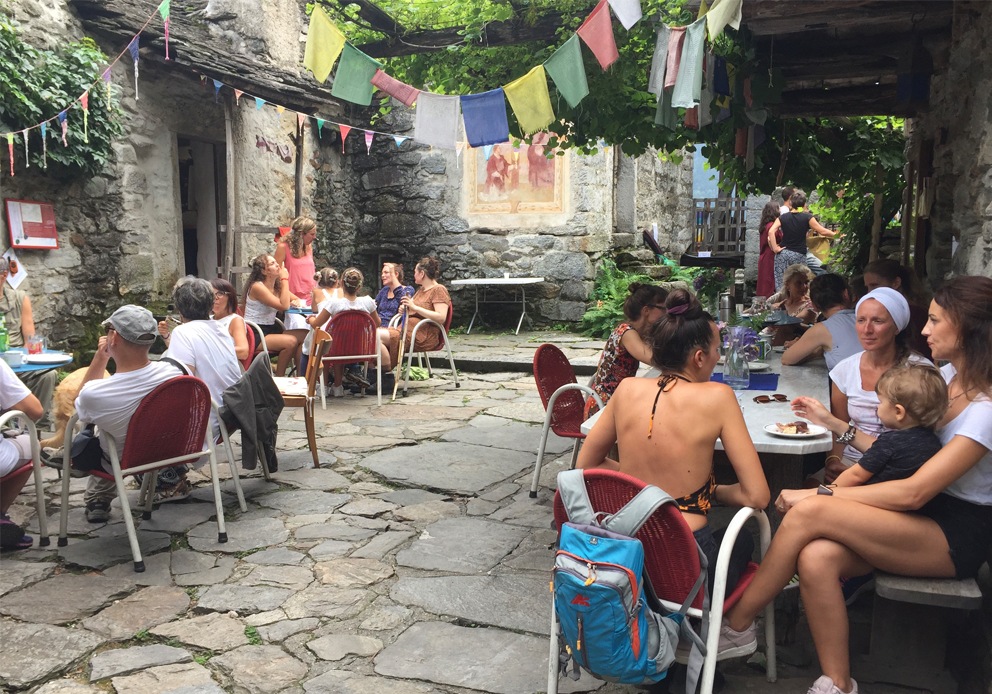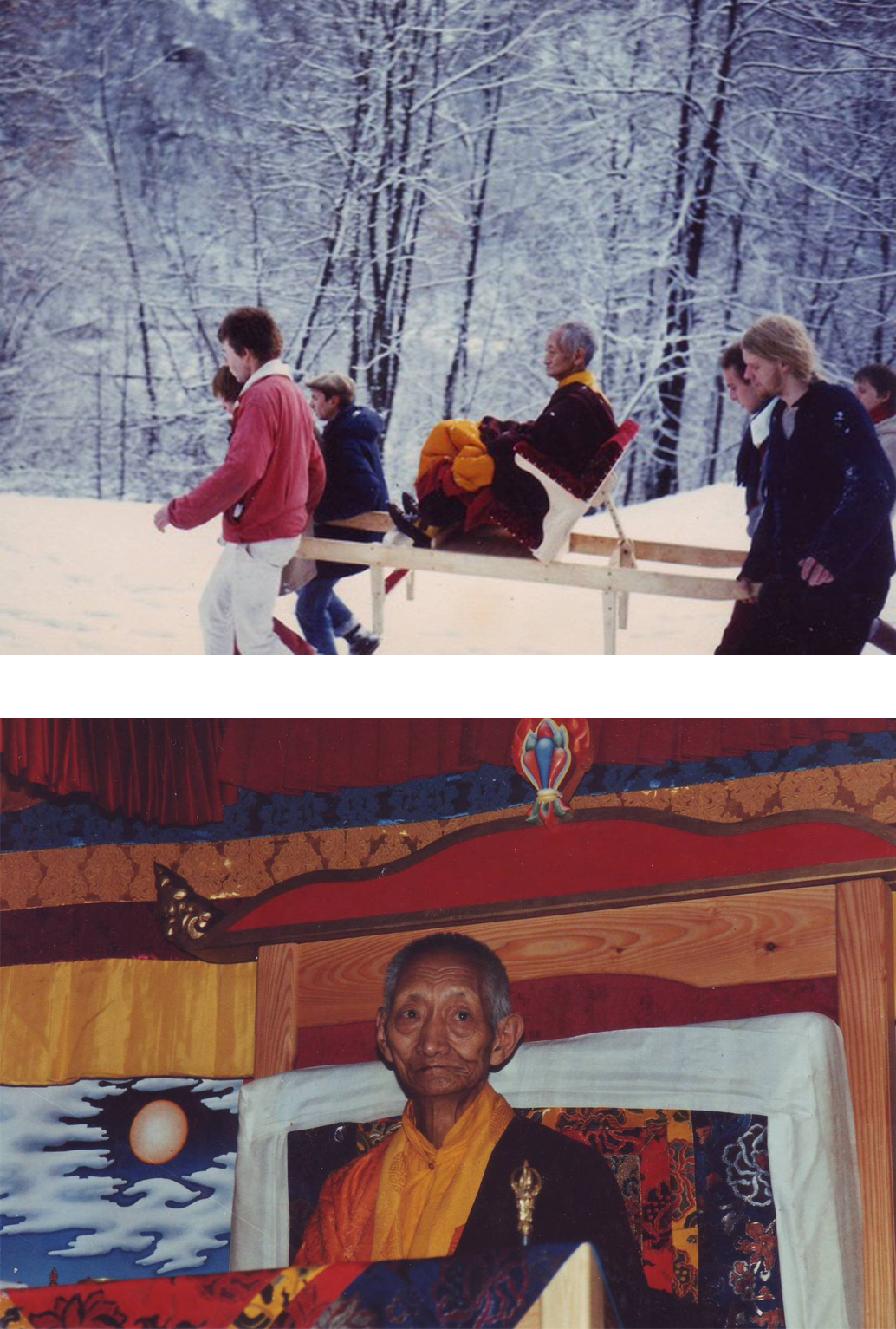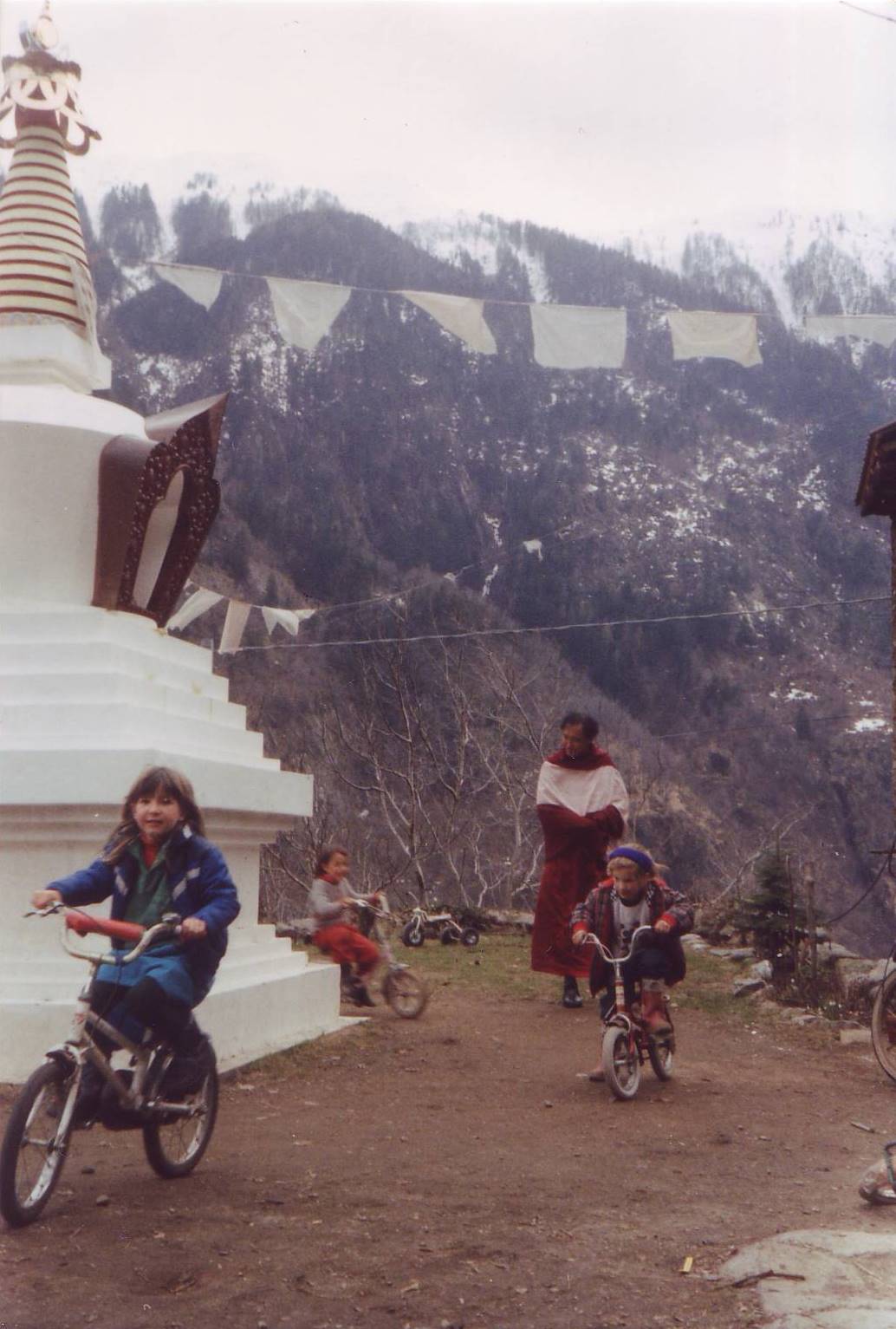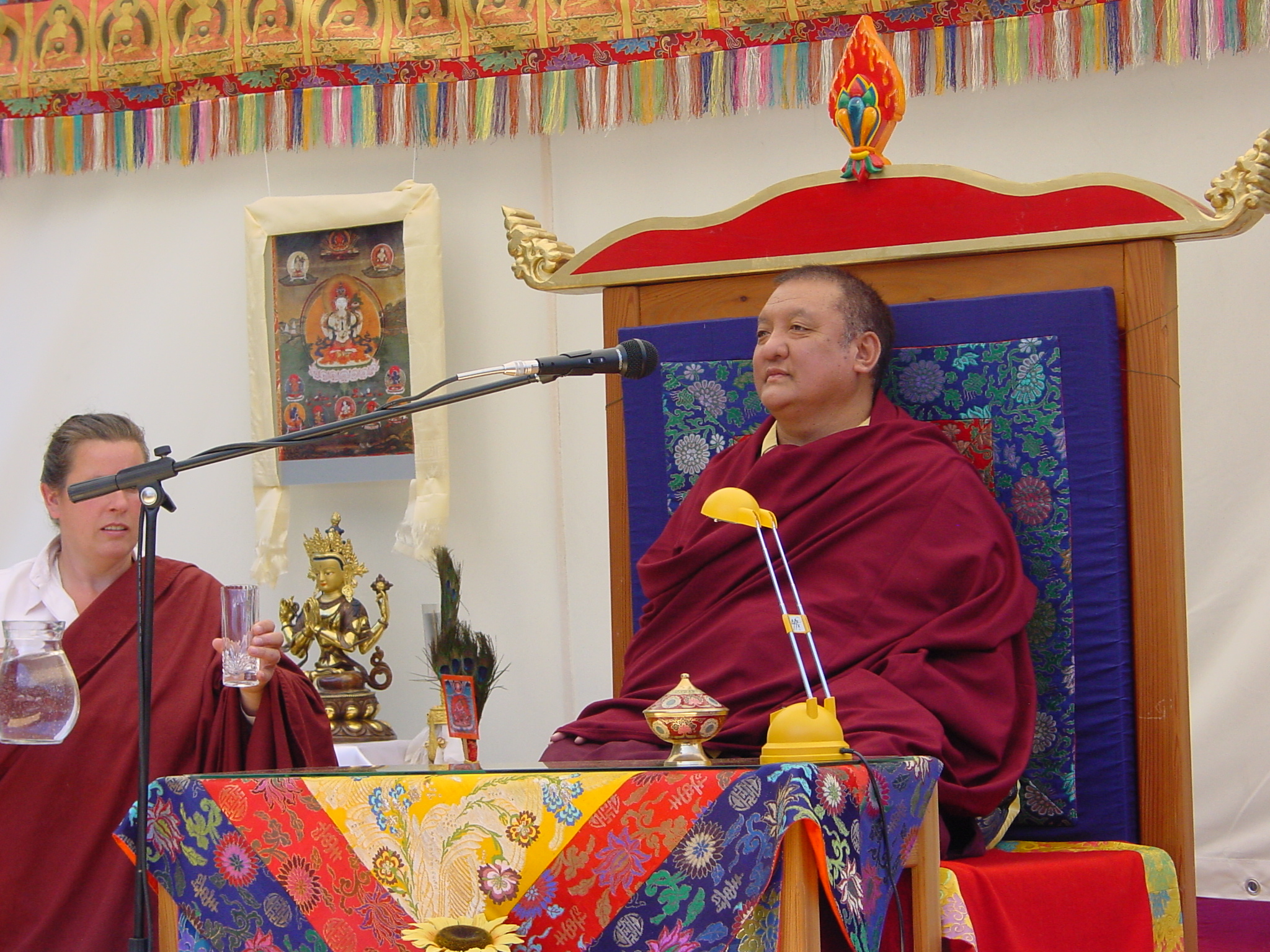Living the Tradition of the Karma Kagyu Lineage in a Mountain Village
The mountain village of Bordo, in Valle Antrona, looks back on a long history. Founded in the Middle Ages in connection with gold and iron ore deposits it was abandoned by its inhabitants in the middle of the 20th century. Gerard Frei, still today connected to the place as the president of the Cooperativa Bordo, owner of the village-project, had the wish to rebuild the houses and to found together with others a community with a spiritual outlook. In 1981 he attended the cremation ceremony of the 16th Karmapa in Rumtek and together with Lama Irene, also still connected to the place today, asked Shamar Rinpoche whether he would give his support. The response was very favourable and Shamar Rinpoche gave the new project the name ‘Karma Dechen Yangtse’ the place of ultimate joy.
The following years saw an intense activity of rebuilding. New members came, children were born and educated, and a rich community life developed for about 15 years. During this time, under the precious guidance of Lama Teunsang from Montchardon, many Rinpoches and Lamas visited the place, helped in the construction of a stupa, conducted rituals and gave teachings.
In 1997 a dharma association was founded. Dharma life was flourishing in connection mainly, but not exclusively, with the Dhagpo Mandala – teachers and Lamas visiting who had studied under the Mahamudra Master Gendun Rinpoche.
2004 and 2006 respectively saw the important visits of Trinley Thaye Dorje, the 17th Karmapa, and Künsig Shamar Rinpoche. Connected with the latter’s visit, the Cooperativa Bordo decided that the dharma village would become a member of the newly founded Bodhi Path organisation, an affiliation still valid today. In 2020 the Fondazione di Partecipazione Karma Dechen Yangtse, headed by Dr. Matteo Bottari from Milan, was founded. This deepens the connection of the village and its functioning to the Dharma and also to the Italian Buddhist Union.
The mountain village of Bordo, with its simple but perfectly adapted traditional stone structures, is striking not only to us today as we come from a way of life of abundance and overconsumption: the Lamas and Rinpoches who had an early background in Tibet were particularly delighted to come to a place which reminded them of their early years in similar, though even more severe surroundings. But the most outstanding feature of Bordo is not its architecture, but its particular quality to serve as a place for meditation and strict retreats. To come to the Antrona valley, leave the bus or the car in Rivera and then take the foot-path which leads up to Bordo, makes you automatically leave your busy worldly occupations and worries behind and enter a space which seems to be out of time.
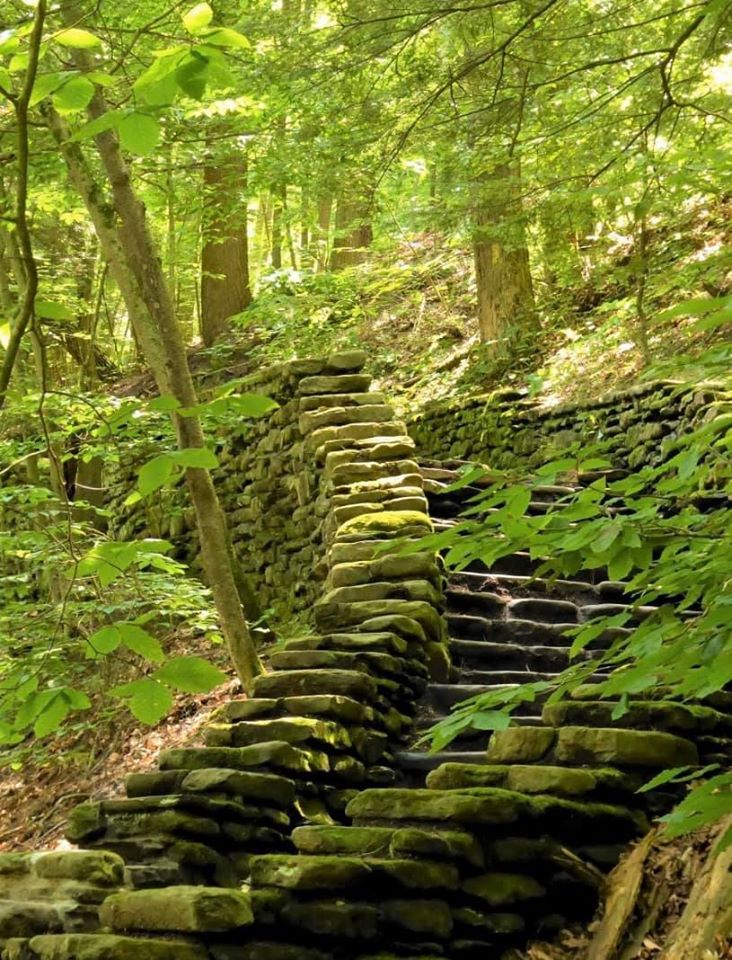
On the way to Bordo
This makes Bordo a place particularly suited to the core practice of the Karma Kagyu tradition: meditation. All masters visiting the place have always stressed its particular quality for meditation practice, in particular the meditation of calm abiding (shine/śamatha) and of Lojong – Mind Training.
The main practice within the Karma Kagyu tradition is called Mahāmudrā practice. Gampopa Sönam Rinchen (1079-1153), one of the forefathers of this tradition, explained the different ways to approach this meditative practice, each of which addresses itself to specific capacities of the practitioner.
The first approach is by the way of conceptual understanding based on the sūtra teachings of the Mahāyāna. Through logical reflection one arrives at an intellectual understanding. It is a vipassanā practice common to all Buddhist approaches. Even though the term Sūtra Mahāyāna in general has a much wider implication, in the present context it is synonymous with logical reasoning and sūtra teachings. Gampopa called it ‘the path of interference’. Particularly important in this approach are a stable mind, to foster a positive attitude towards others and to purify the negative emotions connected with anger, greed, attachment, jealousy and ignorance.
The second path is the tantric Vajrayāna. In this approach one meditates on a mandala and identifies oneself with its specific deity or a Buddha aspect, recites mantras and engages in yogic practices. Gampopa called it ‘the path of blessing’. This approach, connected with particular obligations and instructions, is a powerful way of purification and transformation.
The third is ‘the path of direct perception’, Mahāmudrā meditation itself. It is a practice without the support of intermediary means, resulting in a direct experience that can neither be verbally expressed nor conceptually imagined. Here mind spontaneously recognizes its deep inborn nature and a qualified teacher only guides an outstanding pupil and gives support to stabilize the realisation.
Gampopa Sönam Rinchen particularly stressed the first approach. Having started his training as a monk and practitioner in the Kadampa lineage, founded by Atisha Dipamkara Shrijñana (980-1054) he describes this approach for example in ‘The Jewel Ornament of Liberation’ (Dhagpo Targyen), which still today is a basic reference work not only for the Kagyu lineage. Gampopa no doubt stressed this approach because he thought it approachable for all, although he was also familiar with the tantric approach, as in later years he had become one of the main disciples of the great yogi Milarepa (1052-1135) and received the whole tantric transmission from him.
A tantric approach to Mahamudra meditation was brought to Tibet by Milarepa’s teacher, the great translator Marpa (1012-1097). He received the transmissions in India from the erudite Mahasiddha Naropa (1016-1100), himself based on the tradition of the Mahasiddha Tilopa (988-1069).
A direct approach to Mahamudra, going back to the Mahasiddha Saraha (dates in debate) came down to Marpa through the Mahasiddha Maitripa (ca.1007-1085). It is a very deep method, beyond any intellectual grasping and exhausting all illusionary perception.
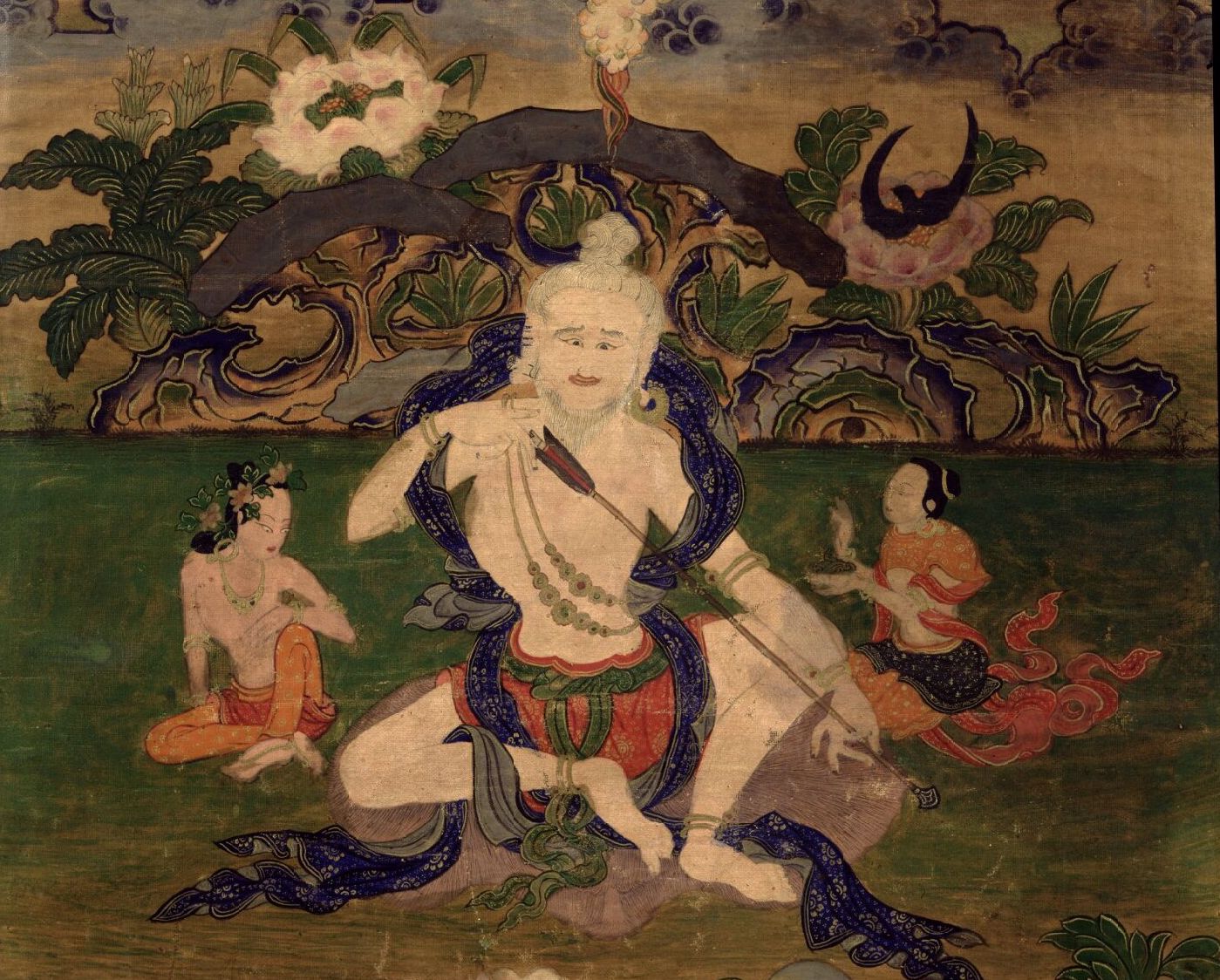
Detail from a thangka depicting the Mahasiddha Saraha
But whatever the approach – to go deeper in meditation is not something one can do just by oneself. Mind is highly attached to its projections. To be able to transcend one’s limits it is necessary to be guided by a qualified teacher, who him- or herself has realised the essence of the uncontrived mind. Deep trust and devotion are necessary to be able to let go of the attachment to deep-lying patterns and projections.
With Gampopa Sönam Rinchen and his texts we have the first extensive explanations of the basic approach of the Kagyu lineage accessible to all. More specific teachings, and especially tantric teachings of the Vajrayana, are passed on from teacher to pupil, and the same is true for specific meditation approaches.
Gampopa had many practitioners following his way, and many of them reached a high level of realisation. The four major and the eight minor lineages of the Kagyu tradition go back to him and one of his main disciples, Phagmo Drugpa Dorje Gyalpo (1110-1170). Many of these lineages have been handed down to the present day and there are also teachers and centres in Italy who pass on the respective tradition.
Düsum Khyenpa (1110-1193), another major disciple of Gampopa, is at the origin of the Karma Kagyu tradition. He is known as the 1st Karmapa and started Tibet’s oldest line of reincarnate teachers. His successors and lineage holders preserved the Karma Kagyu tradition, one of the four mayor lineages of Tibetan Buddhism, together with other spiritual lineages of Tibetan Buddhism, in its richness until today. Bordo is connected to this tradition, as are the Dhagpo centres in Italy and the centres of the Diamond Way Foundation.
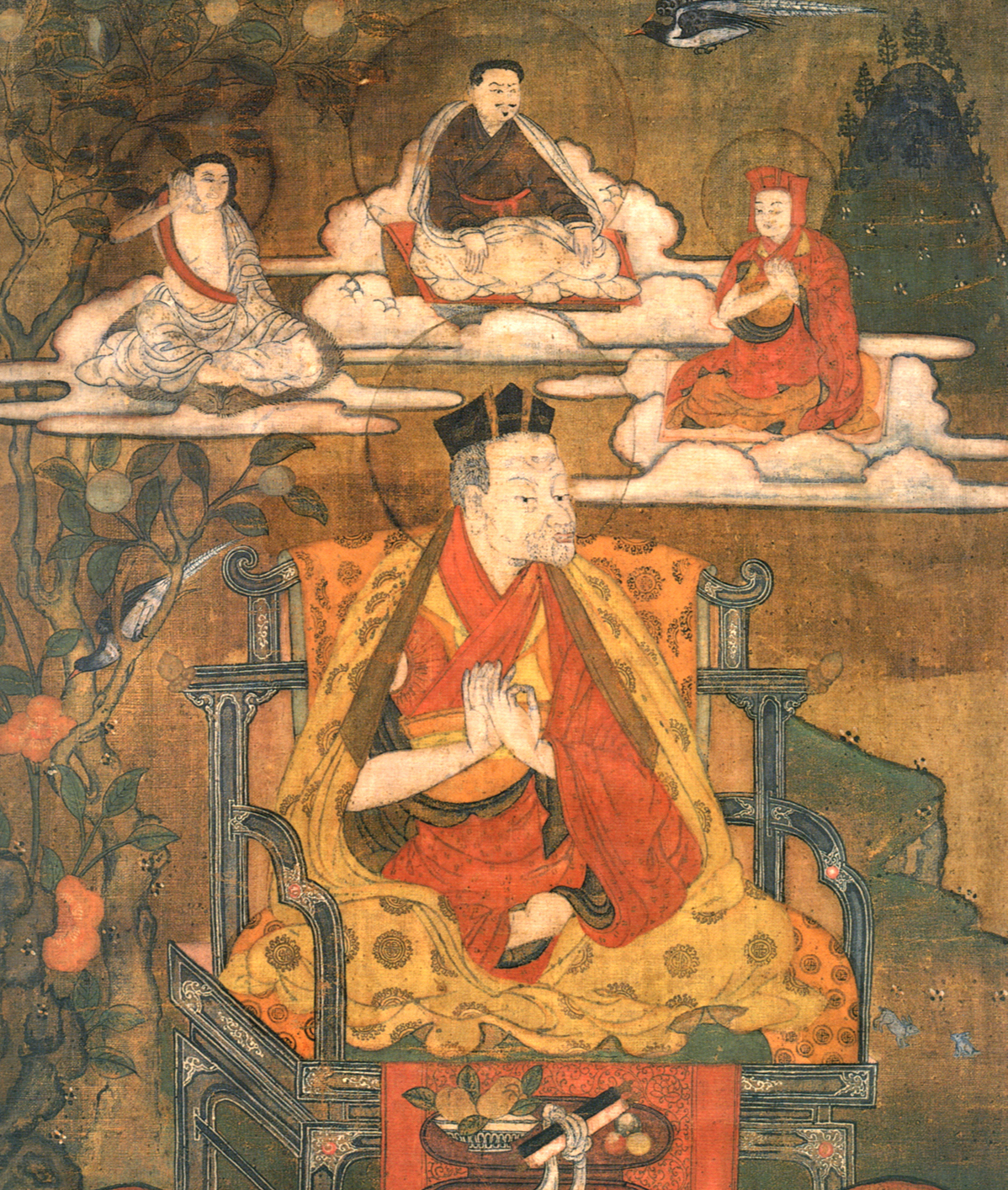
Detail from a thangka depicting Milarepa, Marpa, Gampopa and in the centre Düsum Khyenpa
The emphasis on meditation in the Kagyu lineage does not mean that studies are neglected. A correct understanding of the view is difficult to achieve only through meditation, and there is a great danger (unless one is expertly tutored) in going in too personal a direction. Therefore emphasis is laid on an equal combination of study of the classical texts and the teachings received, of a thorough reflection and integration of their meaning, and of meditation on our actual level with the appropriate background teaching. With time, serious practitioners might choose to deepen their study in one of the academies for higher Buddhist studies of the lineage, with the perspective of passing on the teachings in the future, doing a traditional retreat of three years and three months, or perhaps deepening the ritual aspects of tantric practices.
In Bordo itself we do not teach advanced philosophy, but remain with the basic teachings, as our aim is to be open also for people who are approaching Buddhism or who wish to apply and deepen its teachings in everyday life. An exception is made when one of the Rinpoches or learned Lamas of our lineage visits the place and gives teachings. But in a daily approach we stress the meditation of calm abiding, of tonglen (giving and receiving), and in the evening we perform a Chenrezig puja, a Vajrayana practice open to all which connects us to our inherent loving kindness and compassion.
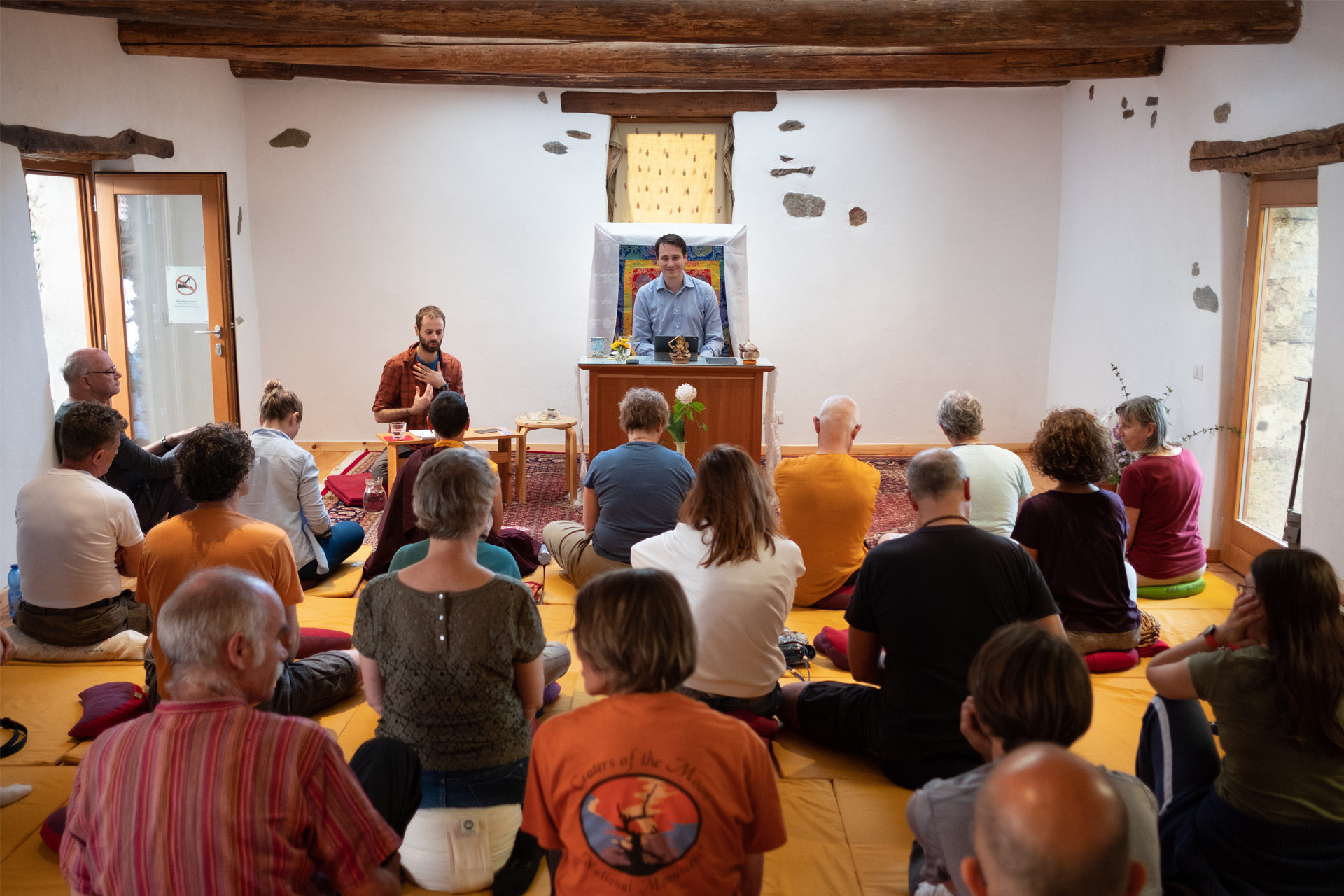
Karma Trinley Tulku gives teachings in the new Sala Milarepa, 2018
Of great importance for beginners as for advanced practitioners alike is a reflection on the four fundamental thoughts which turn our mind towards the dharma. To become aware of our precious human existence allows us to practice. To understand the fleetingness of every experience connects us to the impermanence of life. To see that every act, every word and every thought has a consequence makes us understand that in our present situation we experience the result of our past actions. And finally to see the unsatisfactory nature of samsaric existence allows us to take the firm decision to change our goal in life. For such reflections and their integration in a quiet but demanding daily life and practice, Bordo is very suitable and even complete beginners can participate.
Our study, reflection and meditation equip us with the two inseparable wings of wisdom and compassion to overcome our present unsatisfactory condition. Wisdom refers to emptiness, to the fact that all phenomena are devoid of any substantial and independent existence. This delicate and often wrongly understood point cannot be deepened only by an intellectual approach. Compassion is the wish that all sentient beings could be free of suffering and the cause of suffering, intrinsically connected to the understanding of interdependent existence, knowing that nothing exists by and of itself.
To deepen this understanding and to have a realisation which truly transcends our daily experience is for the expert. But Bordo, with its very particular atmosphere, allows us quite easily to let go of habitual tendencies and of our constant need to affirm our self. The work outside in nature, plain but tasty food, simple rooms to live in, the company with likeminded people, daily common practices and regular inputs on basic themes help all to work and grow together. Experienced practitioners deepen their understanding and foster loving kindness and compassion in an everyday setting with others. Newcomers get a first introduction, might even take refuge and when leaving can join a Dharma centre where they live. For all of us, practitioners coming from the outside as well as the volunteers taking care of the village and its structures, the time spent in Bordo is a challenging and rich experience.
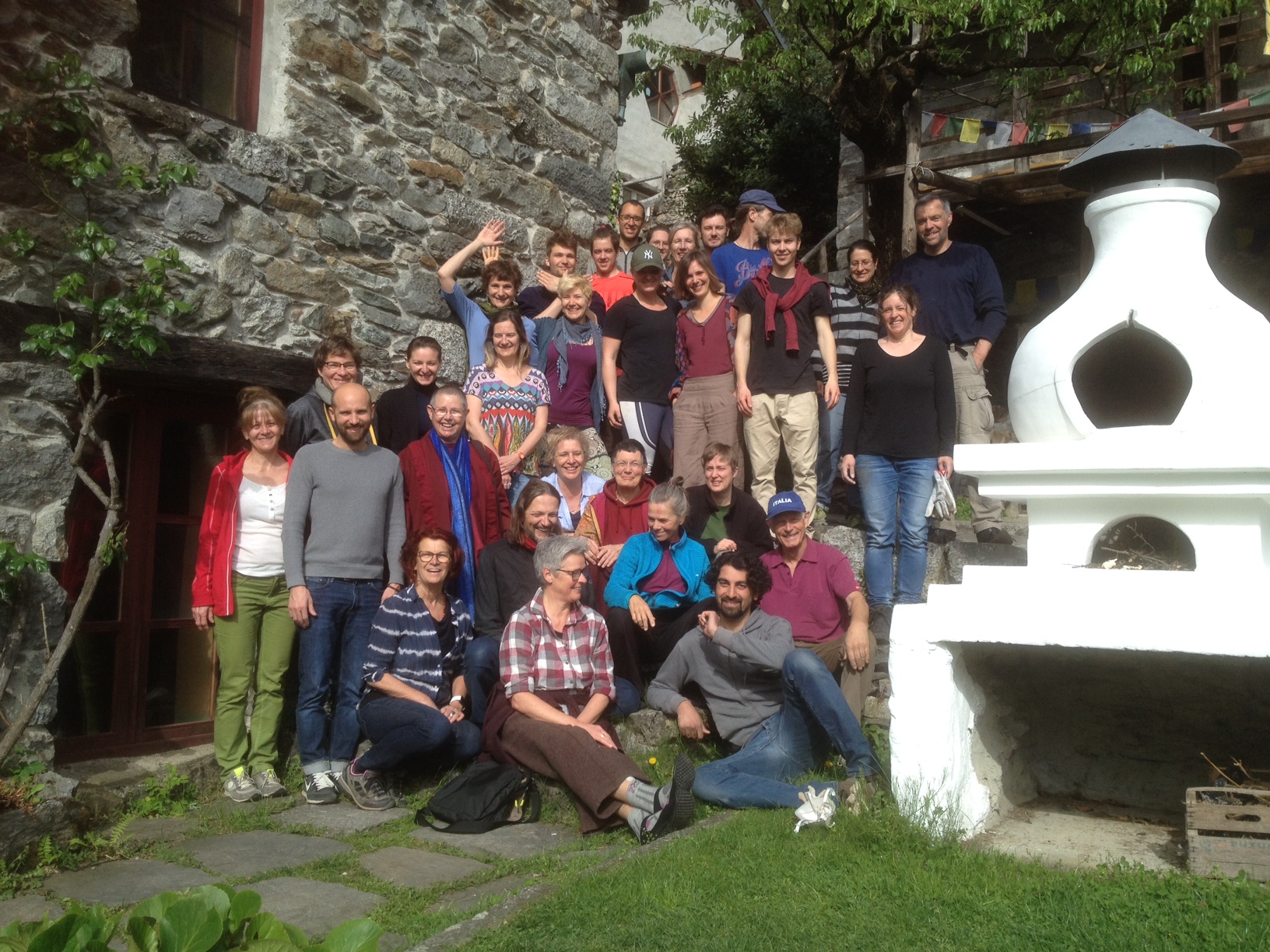
Participants and volunteers after Lama Irene’s Lojong course, 2019
In Bordo only teachings in the Karma Kagyu tradition are given and this only by acknowledged teachers. There is a special focus on the Bodhi Path approach, a way of study, reflection and meditation developed by Shamar Rinpoche to permit western students a current but authentic approach to the teachings of the lineage. A notable exception, suggested to us by Lama Jigme Rinpoche, who is supervising the spiritual development of the place, is a sharing weekend around Vesak, where we invite teachers of different buddhist traditions to share their approach to meditation of calm abiding. We are conscious that one of the riches of Buddhism is the many and different ways of approaching the same goal: to see the inherent unsatisfactory nature of our existence, to see the origin of it, to be persuaded that there is a way to overcome it, and to be convinced that the teachings of the Buddha can show us the way. But the way to enter into this long and deep path is specific for each tradition. To mix approaches does not help us to get a deeper understanding, which in any case finally lies outside of our intellectual grasp. We have to let go of distractions and for this we have to focus on the essentials. In this, every buddhist tradition has its own specific approach.
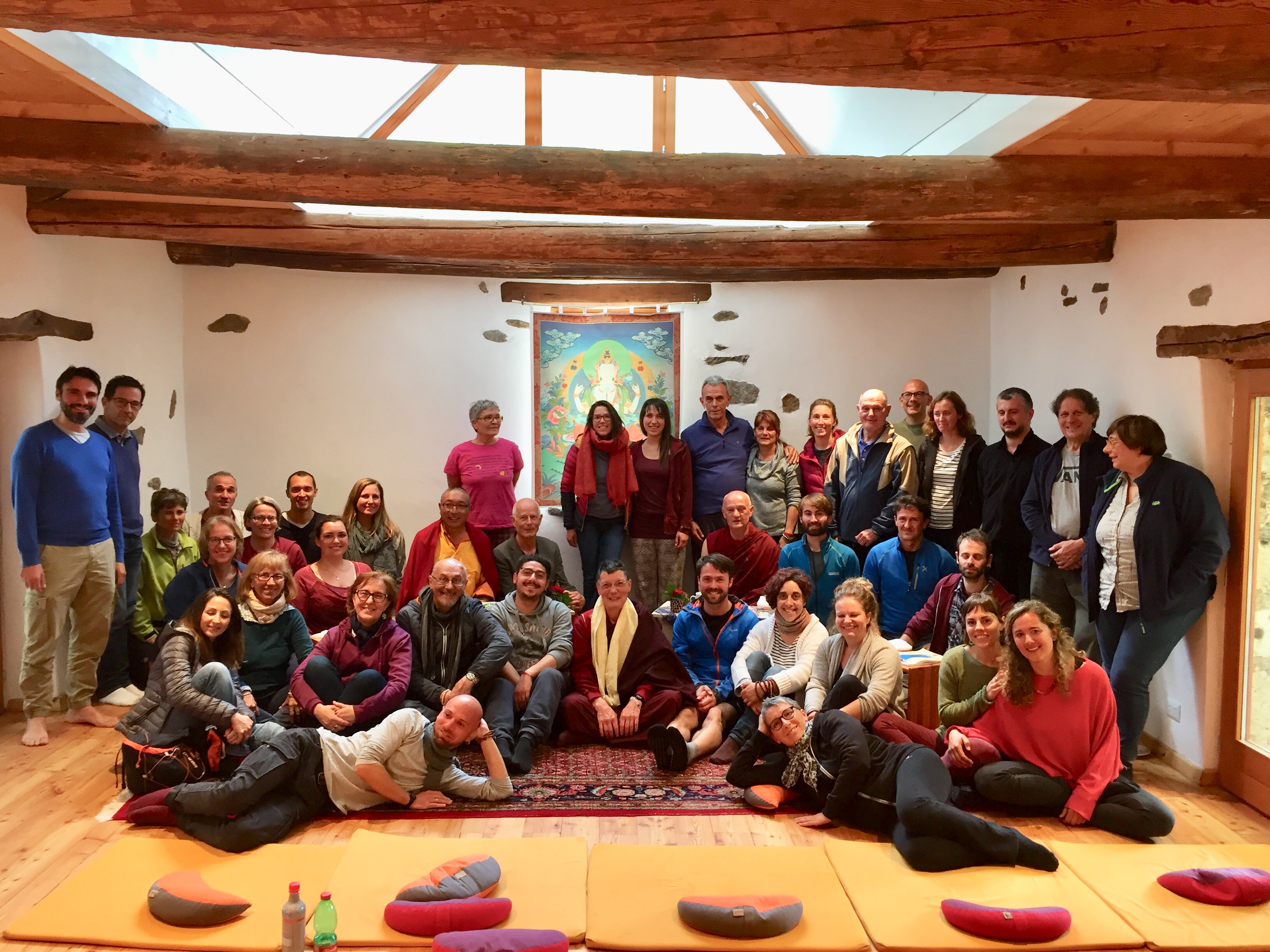
Exchange on shine meditation with Trehor Lama and the monk Cesare Milani, 2019
This alignment towards the precious tradition of our lineage does not mean that practitioners of other Buddhist traditions are not welcome in Bordo. Alone or in a group together with their teacher they are most welcome to benefit from the special qualities of our place for retreat. They can apply, giving us information about the desired time and the practice they intend to do, about the teacher with whom they will prepare their retreat, and on the preparations necessary on the part of the team taking care of the place. We would expect you to give an offering for the stay to cover the costs and permit us maintain the village. For further information please consult the page dedicated to single retreats on www.bordo.org where you can also find information on our programme and visiting teachers. For the moment only practitioners who are very familiar with Bordo, are ready to face low temperatures and know how everything functions can come at certain times for a winter retreat. We hope very much that this excellent possibility to deepen one’s practice will be open to many in the future.
Many thanks to Audrey Desserrières for her review and suggestions and to Felice Bachmann for information on Italian centres of our lineage.

